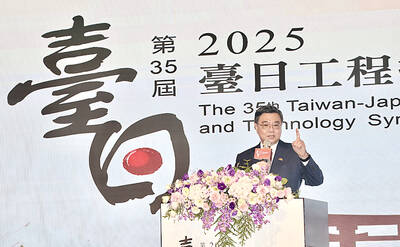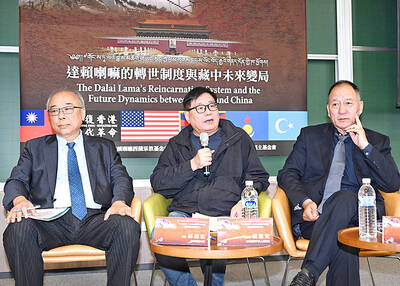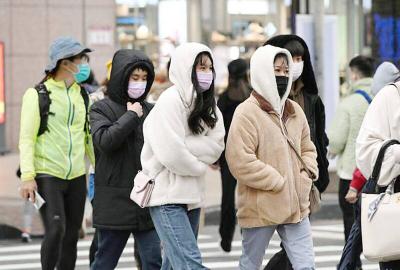When National Chengchi University opened its Center for Prediction Market in March 2006, many were doubtful how accurate its predictions would be.
Four years on, the center has put its name on the map by several times correctly forecasting election outcomes, including the 2008 presidential election. Boasting an accuracy rate of 80 percent to 95 percent, the center is arguably the biggest on-line Chinese-language prediction market.
Prediction markets are speculative exchanges, with the value of an asset meant to reflect the likelihood of a future event. Members can tender virtual bids on events, with the bidding price meant to reflect probability.
Since the University of Iowa established the Iowa Electronic Markets in 1988, prediction markets have boomed.
Many big private companies, such as HP, Yahoo, Microsoft and Google, have set up their own prediction markets to forecast the results of new products, marketing strategies and finances.
Media outlets have also established them, including the CNN Political Market, the Financial Times’ FT PREDICT and the Wall Street Journal’s WSJ Political Market.
The Center for Prediction Market’s Future Events Trading Market, which started operations in July 2006, is open to anyone.
The center’s chief executive, Lin Jih-wen (林繼文), said its predictions were better than opinion polls because traders made their predictions based on objective analysis rather than individual bias.
“Traders earn a profit if their predictions are correct, so the more accurate their forecasts, the more profit they make,” he said.
Prediction centers do better than surveys because poll respondents are randomly picked and might answer dishonestly because they don’t want reveal their positions or are uncertain, he said.
Accurate predictions, however, created problems for the center. Center officials noticed an unusual increase in investors in 2007 before the presidential election, but they didn’t take any action because they thought any futures market could be subject to manipulation, which was not necessarily a bad thing.
It was a problem, however, when it went too far. The center experienced a similar problem during last year’s legislative by-elections. To fix the problem, trading was shut down for more than 10 days, while the center redesigned the registration and trading system.
Despite the new mechanisms, Lin said the center could not guarantee the problem would not happen again.
However, one thing is certain — the center is not facing the problem alone. The Taiwan Political Exchange, the country’s first prediction market, saw a surge of traders in the lead up to the 2008 presidential election.
The Taiwan Political Exchange was established by Academia Sinica’s Institute of Physics in 2003 to gauge the 2004 presidential poll, but it has not been as active as Chengchi University’s center.
Tseng Jie-jun (曾玠郡), a researcher at the Taiwan Political Exchange, said the exchange’s low-key approach was because its purpose was to study trader behavior, not forecast election outcomes.
The exchange also wanted to avoid undue attention and market manipulation, he said.
The center has issued only four contracts since 2003, he said, and they were all on major elections, including the 2008 presidential poll.
With the elections in the five special municipalities set for late November, Tseng said the exchange would launch a promotion campaign three months beforehand to attract traders.
About 300 to 400 participants would be enough to provide good results, Tseng said, while more than 1,000 samples would be allow for in-depth research.
Although participants did not trade in real money, the exchange gives cash rewards to the top 10 traders and publicizes their trading accounts to boost interest in the exchange.
Traders of the Center for Prediction Market use “funny money” in their trades.
Center for Prediction Market director Tung Chen-yuan (童振源) said the center was established for education and research purposes. It had neither the manpower nor the resources to administer trades in real money, and it also didn’t want to cause trouble.
Trouble is the least thing a futures market wants.
The Ireland-based online sports trading exchange TradeSports collapsed in November 2008 because of mistakes it made, including faulty contracts and inaccurate game settlements.
Tung said the Center for Prediction Market makes predictions on various issues, which are classified into eight categories: politics, elections, economy, social affairs, cross-strait affairs, international affairs, entertainment and sports.
As of April, the center had issued 13,437 contracts in its four years of operation, and received more than 214 million trading entries from 121 countries.
Of its participants, 80 percent are from Taiwan, 10 percent from China and rest come from around the world.
Why would people participate in trades and predictions when real money is not involved?
Tung said traders received a sense of achievement. They earned profits in proportion to the quality of information they provided and they could buy and sell at any time based on new information, he said.
The Center for Prediction Market might soon be facing new competition. Media reports say a New Zealand company, iPredict, is planning to venture into Taiwan.
iPredict is New Zealand’s first real money prediction market. Its investors bet on future political, economic, business and social events and the company claims its top traders earned returns of more than 2,000 percent.

ALIGNED THINKING: Taiwan and Japan have a mutual interest in trade, culture and engineering, and can work together for stability, Cho Jung-tai said Taiwan and Japan are two like-minded countries willing to work together to form a “safety barrier” in the Indo-Pacific region, Premier Cho Jung-tai (卓榮泰) yesterday said at the opening ceremony of the 35th Taiwan-Japan Modern Engineering and Technology Symposium in Taipei. Taiwan and Japan are close geographically and closer emotionally, he added. Citing the overflowing of a barrier lake in the Mataian River (馬太鞍溪) in September, Cho said the submersible water level sensors given by Japan during the disaster helped Taiwan monitor the lake’s water levels more accurately. Japan also provided a lot of vaccines early in the outbreak of the COVID-19 pandemic,

Kaohsiung Mayor Chen Chi-mai (陳其邁) on Monday announced light shows and themed traffic lights to welcome fans of South Korean pop group Twice to the port city. The group is to play Kaohsiung on Saturday as part of its “This Is For” world tour. It would be the group’s first performance in Taiwan since its debut 10 years ago. The all-female group consists of five South Koreans, three Japanese and Tainan’s Chou Tzu-yu (周子瑜), the first Taiwan-born and raised member of a South Korean girl group. To promote the group’s arrival, the city has been holding a series of events, including a pop-up

TEMPORAL/SPIRITUAL: Beijing’s claim that the next Buddhist leader must come from China is a heavy-handed political maneuver that will fall flat-faced, experts said China’s requirement that the Dalai Lama’s reincarnation to be born in China and approved by Beijing has drawn criticism, with experts at a forum in Taipei yesterday saying that if Beijing were to put forth its own Dalai Lama, the person would not be recognized by the Tibetan Buddhist community. The experts made a remarks at the two-day forum hosted by the Tibet Religious Foundation of His Holiness the Dalai Lama titled: “The Snow Land Forum: Finding Common Ground on Tibet.” China says it has the right to determine the Dalai Lama’s reincarnation, as it claims sovereignty over Tibet since ancient times,

Temperatures in some parts of Taiwan are expected to fall sharply to lows of 15°C later this week as seasonal northeasterly winds strengthen, the Central Weather Administration (CWA) said today. It is to be the strongest cold wave to affect northern Taiwan this autumn, while Chiayi County in the southwest and some parts of central Taiwan are likely to also see lower temperatures due to radiational cooling, which occurs under conditions of clear skies, light winds and dry weather, the CWA said. Across Taiwan, temperatures are to fall gradually this week, dropping to 15°C to 16°C in the early hours of Wednesday